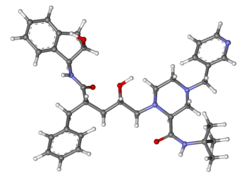Chemistry:Indinavir
 | |
 | |
| Clinical data | |
|---|---|
| Trade names | Crixivan |
| AHFS/Drugs.com | Monograph |
| MedlinePlus | a696028 |
| License data | |
| Pregnancy category |
|
| Routes of administration | Oral |
| ATC code | |
| Pharmacokinetic data | |
| Bioavailability | ~65% |
| Protein binding | 60% |
| Metabolism | Hepatic via CYP3A4 |
| Elimination half-life | 1.8 ± 0.4 hours |
| Identifiers | |
| |
| CAS Number | |
| PubChem CID | |
| DrugBank | |
| ChemSpider | |
| UNII | |
| KEGG | |
| ChEBI | |
| ChEMBL | |
| NIAID ChemDB | |
| PDB ligand | |
| Chemical and physical data | |
| Formula | C36H47N5O4 |
| Molar mass | 613.79 g/mol g·mol−1 |
| 3D model (JSmol) | |
| |
| |
| | |
Indinavir (IDV; trade name Crixivan, manufactured by Merck) is a protease inhibitor used as a component of highly active antiretroviral therapy to treat HIV/AIDS.
It is on the World Health Organization's List of Essential Medicines, a list of the most important medications needed in a basic health system.[2]
Medical uses
Unfortunately, indinavir wears off quickly after dosing, so requires very precise dosing every eight hours to thwart HIV from forming drug-resistant mutations, including resistances to other protease inhibitors. It has restrictions on what sorts of food may be eaten concurrently. For these reasons it is now rarely used.
Side effects
The most common side effects of indinavir include:[3]
- Gastrointestinal disturbances (abdominal pain, diarrhea, nausea, vomiting)
- General malaise and fatigue
- Nephrolithiasis/urolithiasis (the formation of kidney stones), which sometimes may lead to more severe condition including kidney failure
- Metabolic alterations including hyperlipidemia (cholesterol or triglyceride elevations) and hyperglycemia
- Alterations in body shape (lipodystrophy), colloquially known as "Crix belly"[4]
Indinavir inhibits urinary nitrous oxide production and may inhibit nitric oxide production. Treatment with this drug is frequently associated with renal abnormalities, sterile leukocyturia, and reduced creatinine clearance.[5]
Indinavir impairs endothelial function in healthy HIV-negative men and may accelerate atherosclerotic disease.[6]
History
The Food and Drug Administration (FDA) approved indinavir on March 13, 1996, making it the eighth antiretroviral drug approved. Indinavir is much more powerful than any prior antiretroviral drug; using it with dual NRTIs set a new standard for treatment of HIV/AIDS.[citation needed] Protease inhibitors changed the nature of AIDS from a terminal illness to a somewhat manageable one.[citation needed]
Increasingly, it is being replaced by newer drugs that are more convenient to take and less likely to promote virus resistance, such as darunavir or atazanavir.
References
- ↑ Liu, F.; Boross, P. I.; Wang, Y. F.; Tozser, J.; Louis, J. M.; Harrison, R. W.; Weber, I. T. (2005). "Kinetic, Stability, and Structural Changes in High-resolution Crystal Structures of HIV-1 Protease with Drug-resistant Mutations L24I, I50V, and G73S". Journal of Molecular Biology 354 (4): 789–800. doi:10.1016/j.jmb.2005.09.095. PMID 16277992.
- ↑ "WHO Model List of EssentialMedicines". World Health Organization. October 2013. http://apps.who.int/iris/bitstream/10665/93142/1/EML_18_eng.pdf?ua=1. Retrieved 22 April 2014.
- ↑ "Crixivan® (indinavir sulfate) Capsules. Prescribing Information. Revised December 2013". Merck & Co., Inc.. http://www.merck.com/product/usa/pi_circulars/c/crixivan/crixivan_pi.pdf. Retrieved 6 February 2014.
- ↑ Capaldini, L (1997). "Protease inhibitors' metabolic side effects: cholesterol, triglycerides, blood sugar, and "Crix belly"". AIDS Treatment News (277): 1–4. PMID 11364559.
- ↑ M. Eira, M. Araujo and A.C. Seguro. Urinary NO3 excretion and renal failure in indinavir-treated patients. Brazilian Journal of Medical and Biological Research (2006) 39: 1065-1070.
- ↑ Shankar SS, Dubé MP, Gorski JC, Klaunig JE, Steinberg HO. Indinavir impairs endothelial function in healthy HIV-negative men. Am Heart J. 2005 Nov;150(5):933.
 |


